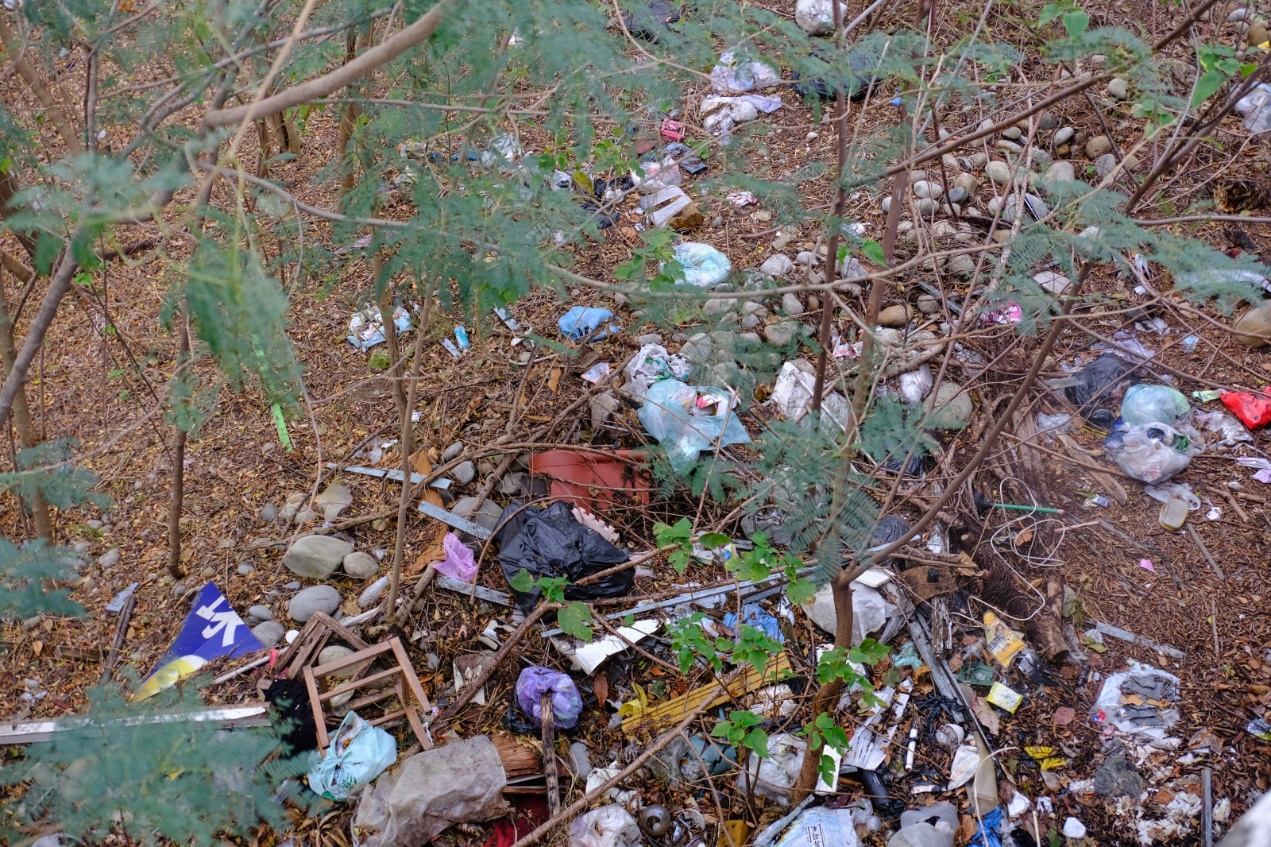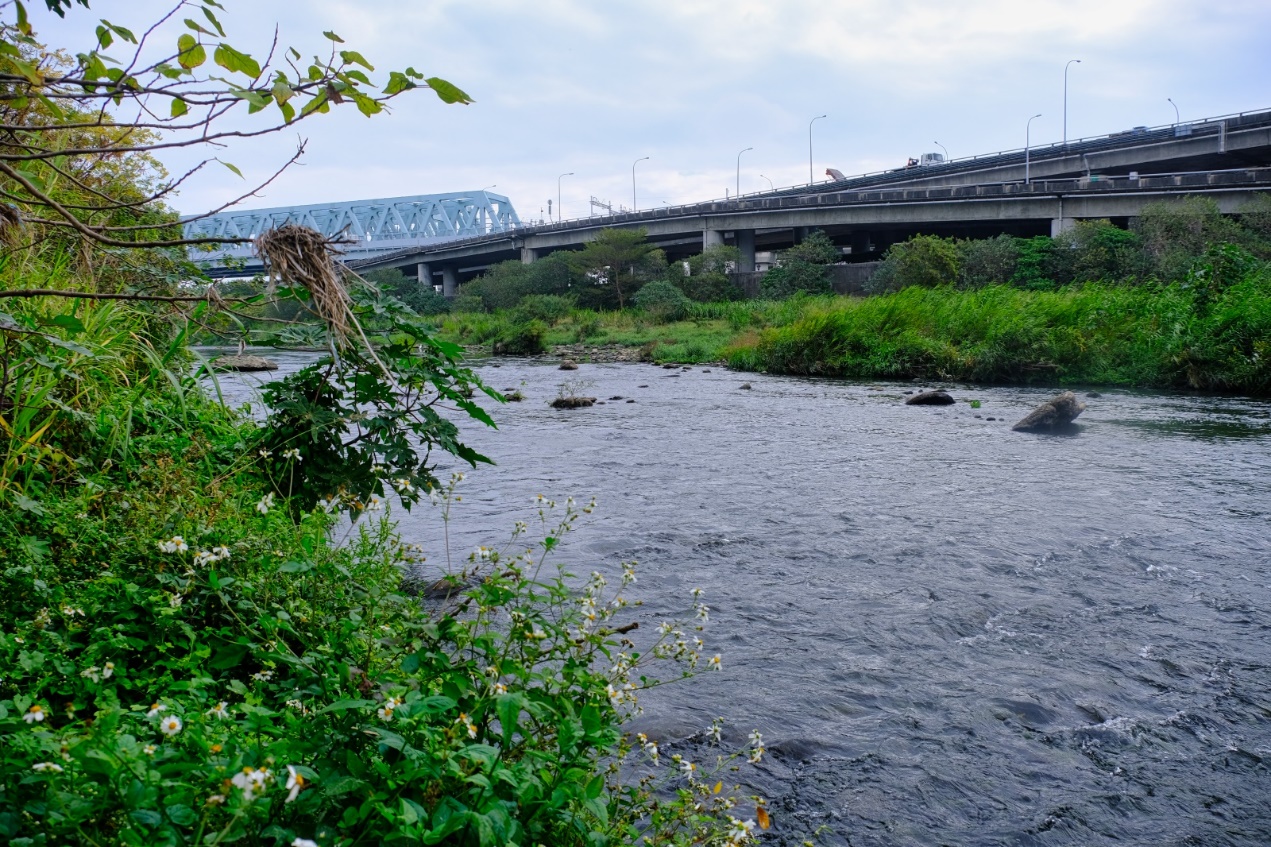According to statistics, river water (45%) accounts for the highest percentage of all major sources of water in Taiwan. Therefore, for this week’s program on World Water Day, March 22 starts with you protecting the rivers and caring for water resources.
To determine the pulse flow on rivers, the Society of Wilderness began the “River Waste Screening Rapid-Survey” project in 2019. In 2021, an investigation was conducted in the basin and outlet of Taichung´s Wu River where 1,092,686 liters of waste were found accumulated in 215.5 kilometers. Based on the 14-liter garbage bags commonly used in Taipei and New City, there were 78,049 bags of garbage at the basin, or an average of nearly 400 bags of garbage per kilometer of the surveyed area. After comparing the survey data of the Tamsui River in 2020, it was found that the density of garbage in the Wu River basin was 80% higher than that found in the Tamsui River.

Huanhe Road Section 4 is near Gaotie East Road where many household waste is scattered on the high river bank. Judging by the degree of pollution and weathered plastic bags, most of it had been recently disposed of.
Household waste scatters within the riverbank near the high-speed railway
On the day of the interview, we arrived at the intersection of Huanhe and Gaotie East Road in Wuri District, Taichung City, where we followed Commissioner Yang Cheng-Ying of the Society of Wilderness. It was close to the Taichung High Speed Rail, and the traffic was heavy. The elevated section of Highway 74 came to view. Turning west along Huanhe Road to the Sun Yat-Sen Interchange, not far, on the of the Wu River is the Kuaiguan-Wufeng Expressway of the Formosa Freeway. It is here where the Wu River Fa-Zi Stream merges into the mainstream and also the location of one of the three major waste hotspots in Wu River.
On the south side of Huanhe Road Section 4, the sidewalk walls, with a height of the chest of an average adult, are the embankment of the Wu River. The high river bank outside the embankment is nearly two stories high from the top of the embankment. For this reason, the high river bank is not visible when walking on the sidewalk, unless you climb up the wall. We followed Yang up the embankment and looked down at the riverbank. What we saw was an uncountable amount of garbage bags!
After taking a closer look, many bags were still securely packed with garbage inside them. From mere sight, we assumed it was household waste and large interior decorating items such as cabinets and washbasins. Most of the trash was gathered close to the embankment, with no signs of sediment or weathering in the environment, presumably from recent fly-tipping by people who drove there in the middle of the night and dumped the bags down the embankment. Out of sight, out of mind. Yang visually estimated that the amount of garbage scattered along this 100-meter stretch of riverbank would be more than 200 bags, and considering 14-liter garbage per bag, resulting in over 2,800 liters.
Rivers converge in the sea, and the waste of rivers converges in the ocean
Why does the Society of Wilderness care about water pollution? Yang explained that the Society of Wilderness had conducted many beach cleanups in the past, but gradually realized that beach cleanups are not the only solution for cleaning the ocean. Since rivers and oceans are linked together, many urban waste is washed downstream along rivers and streams, and finally flows into the ocean. “Rivers become a very important conveyor belt.” Therefore, only by solving the problem of waste on land and rivers can we reduce the amount of waste from entering the ocean.
However, the issue of river waste has only gained attention in recent years. Yang is concerned that many rivers may have already accumulated a striking amount of waste, which if not cleaned properly, will eventually end up flowing into the ocean. Additionally, plastic waste may also be broken down into plastic particles through sun and rain exposure. Once these microplastics enter the water, it is difficult to remove them completely and may even accumulate in living organisms harming humans through the food chain.
Although the Environmental Protection Administration (EPA) has conducted a River Pollution Index (RPI) survey on the water quality of rivers, the project does not include river waste, so the amount of river waste in the country is still unknown. Thus, recently the Society of Wilderness has expanded its attention from marine waste to river waste. They have officially launched the “River Waste Screening Rapid-Survey” in 2019 hoping to let “numbers” speak for rivers.
A Low Carbon, Paperless, Environmentally Friendly Citizen Scientific Survey
To design a proper methodology to conduct local river waste surveys, at the end of 2019, the Society of Wilderness held a workshop on “Quick Screening Techniques for River Waste” and invited Japanese scholar Professor Shigeru Fujieda to Taiwan to participate in an academic exchange. Professor Fujieda, who teaches at Kagoshima University, has been concerned about the issue of marine and river waste for a long time. In 2007, he rode a bicycle for thousands of kilometers to investigate the distribution of waste in 13 major rivers in the Seto Inland Sea.
The quick screening survey in the Wu River was a reformed version of Professor Fujieda’s survey method which was conducted in a low-carbon and paperless manner. Volunteers were invited to act as “citizen scientists” by conducting surveys either by bicycle or by foot. Visual observations were made in 500-meter intervals known as sections to estimate the volume of trash per section to record its distribution and type. The survey also received the support of Fubon Life; therefore, in addition to volunteers from the Society of Wilderness Taichung branch, several Fubon Life employees were invited to serve as surveyors. In addition, a two-day workshop was organized to learn about fast screening surveys.
“Because the estimation is done by visual inspection, the error of fast screening is inevitable,” Yang pointed out. To reduce the deviation of fast screening, the workshop arranged a practical course to simulate a river with a comparable waste distribution and let the surveyors fill 14-liter garbage bags to get familiar with the dimensions of a full 14-liter bag. Furthermore, the survey was designed such that it would be conducted in small groups of 3 to 4 people. This way, group members could discuss and agree on the estimated final values and avoid excessive deviation.
The scope of the survey was estimated to cover 175 km in length, ranging from the left to the right bank of the Wu River including the following tributaries: Fa-Zi Stream, Dali Stream, Han Stream, Tou-Bian-Keng Stream, and Caohu Stream. The survey also included the width of the riverbank within sight. In addition to the riverbank, the survey areas from the left and right banks of the Wu River watershed outlet were set in separate sections, totaling 40.5 km in width, from the waterfront to the sea wall, vegetation, and sand dunes. The total length of the survey was 215.5 km with 431 sections.
There were about 1.1 million liters of waste in Wu River, were plastic products accounted for 60% to 70% of the total waste
The investigation was originally expected to be completed in May 2021 but was delayed until August because of the outbreak of Covid-19. According to the data released by the Society of Wilderness, the total amount of garbage in the Wu River watershed was about 1.1 million liters. Surveyors used the 14-liter garbage bag commonly used in Taipei and New Taipei City as the statistical unit of measurement. This way, it would be possible to fill more than 78 million bags, or an average of 400 bags of waste per kilometer.
However, the distribution of the river waste is extremely uneven, with 80% of the waste volume concentrated in 20% of the surveyed area, in line with the 80/20 rule. The top three riparian areas with the most waste are near the THSR Taichung Station, under the bridge of National Highway No. 1 in Dadui District and at the outlet of Wu River watershed. This shows that by targeting these hot spots for litter removal and continuous monitoring, a significant reduction in litter can be achieved in the Wu River watershed.
In terms of waste composition, 60-70% of the 1.1 million liters of river waste were plastic products, where plastic bags accounted for the largest percent of plastic waste (28.6%), followed by plastic bottles and containers (23%) and disposable plastic products (21.3%). These three types of waste are also widely found on the coast, confirming that river waste is one of the main sources of marine waste.
To make a further hotspot cross comparison, the hotspots in the lower reaches of the river are mainly composed of “broken plastic bottles, plastic bags, disposable tableware and a small amount of Styrofoam”; the hotspots in the middle and upper reaches are usually located at the intersection of riverbanks and hidden areas, and the main composition of garbage is mostly “whole bags of household garbage, large abandoned furniture, business waste, etc.”, which is presumed to be mostly illegal disposal.

Coming to the riverside of Fa-Zi Stream, the gurgling stream is about to merge into the Wu River, and on the other bank, the Provincial Highway 74 and the elevated high-speed rail can be found. The upper riverbank is full of life and is an important ecological corridor in the urban jungle.
Both public and private efforts are being made to protect the beautiful rivers
In response to the survey results, the Society of Wilderness has also proposed adequate policy initiatives. Yang said that the map of waste hotspots has been available to the public; therefore, the government can focus its limited resources on 20% of the river waste hotspots to remove 80% of the trash and maximize the benefits. What’s more, people and community groups who care about the environment can also act to monitor and remove trash from the hotspots. The Society of Wilderness will also continue to promote stream cleaning activities in the future.
River protection often involves many different authorities, the Society of Wilderness not only calls on river management units to set up an inter-ministerial cooperation platform to solve the river waste problem, but also suggests that the government should strengthen waste reduction policies at the source. For example, shopping malls and markets can take measures of renting shopping bags, expanding the scope of the ban to non-washable tableware, speeding up the plastic reduction process, etc. All of this with to achieve the goal of a plastic-free Taiwan.
How far away are you from the river? This episode takes you on a visit to Wuri, Taichung to observe the waste on the banks of the Wu River and to consider what we can do to be kind to the river with Yang Cheng-Ying, the Society of Wilderness Taichung Branch Commissioner.




 中
中